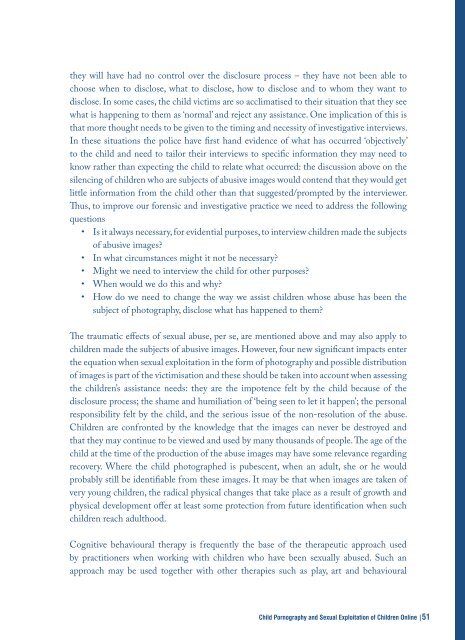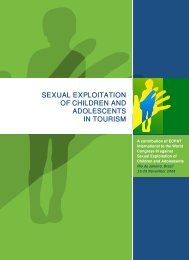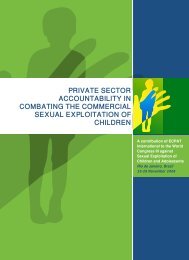to download the document in PDF format - Child Centre: Expert ...
to download the document in PDF format - Child Centre: Expert ...
to download the document in PDF format - Child Centre: Expert ...
You also want an ePaper? Increase the reach of your titles
YUMPU automatically turns print PDFs into web optimized ePapers that Google loves.
<strong>the</strong>y will have had no control over <strong>the</strong> disclosure process – <strong>the</strong>y have not been able <strong>to</strong>choose when <strong>to</strong> disclose, what <strong>to</strong> disclose, how <strong>to</strong> disclose and <strong>to</strong> whom <strong>the</strong>y want <strong>to</strong>disclose. In some cases, <strong>the</strong> child victims are so acclimatised <strong>to</strong> <strong>the</strong>ir situation that <strong>the</strong>y seewhat is happen<strong>in</strong>g <strong>to</strong> <strong>the</strong>m as ‘normal’ and reject any assistance. One implication of this isthat more thought needs <strong>to</strong> be given <strong>to</strong> <strong>the</strong> tim<strong>in</strong>g and necessity of <strong>in</strong>vestigative <strong>in</strong>terviews.In <strong>the</strong>se situations <strong>the</strong> police have first hand evidence of what has occurred ‘objectively’<strong>to</strong> <strong>the</strong> child and need <strong>to</strong> tailor <strong>the</strong>ir <strong>in</strong>terviews <strong>to</strong> specific <strong>in</strong><strong>format</strong>ion <strong>the</strong>y may need <strong>to</strong>know ra<strong>the</strong>r than expect<strong>in</strong>g <strong>the</strong> child <strong>to</strong> relate what occurred: <strong>the</strong> discussion above on <strong>the</strong>silenc<strong>in</strong>g of children who are subjects of abusive images would contend that <strong>the</strong>y would getlittle <strong>in</strong><strong>format</strong>ion from <strong>the</strong> child o<strong>the</strong>r than that suggested/prompted by <strong>the</strong> <strong>in</strong>terviewer.Thus, <strong>to</strong> improve our forensic and <strong>in</strong>vestigative practice we need <strong>to</strong> address <strong>the</strong> follow<strong>in</strong>gquestions• Is it always necessary, for evidential purposes, <strong>to</strong> <strong>in</strong>terview children made <strong>the</strong> subjectsof abusive images?• In what circumstances might it not be necessary?• Might we need <strong>to</strong> <strong>in</strong>terview <strong>the</strong> child for o<strong>the</strong>r purposes?• When would we do this and why?• How do we need <strong>to</strong> change <strong>the</strong> way we assist children whose abuse has been <strong>the</strong>subject of pho<strong>to</strong>graphy, disclose what has happened <strong>to</strong> <strong>the</strong>m?The traumatic effects of sexual abuse, per se, are mentioned above and may also apply <strong>to</strong>children made <strong>the</strong> subjects of abusive images. However, four new significant impacts enter<strong>the</strong> equation when sexual exploitation <strong>in</strong> <strong>the</strong> form of pho<strong>to</strong>graphy and possible distributionof images is part of <strong>the</strong> victimisation and <strong>the</strong>se should be taken <strong>in</strong><strong>to</strong> account when assess<strong>in</strong>g<strong>the</strong> children’s assistance needs: <strong>the</strong>y are <strong>the</strong> impotence felt by <strong>the</strong> child because of <strong>the</strong>disclosure process; <strong>the</strong> shame and humiliation of ‘be<strong>in</strong>g seen <strong>to</strong> let it happen’; <strong>the</strong> personalresponsibility felt by <strong>the</strong> child, and <strong>the</strong> serious issue of <strong>the</strong> non-resolution of <strong>the</strong> abuse.<strong>Child</strong>ren are confronted by <strong>the</strong> knowledge that <strong>the</strong> images can never be destroyed andthat <strong>the</strong>y may cont<strong>in</strong>ue <strong>to</strong> be viewed and used by many thousands of people. The age of <strong>the</strong>child at <strong>the</strong> time of <strong>the</strong> production of <strong>the</strong> abuse images may have some relevance regard<strong>in</strong>grecovery. Where <strong>the</strong> child pho<strong>to</strong>graphed is pubescent, when an adult, she or he wouldprobably still be identifiable from <strong>the</strong>se images. It may be that when images are taken ofvery young children, <strong>the</strong> radical physical changes that take place as a result of growth andphysical development offer at least some protection from future identification when suchchildren reach adulthood.Cognitive behavioural <strong>the</strong>rapy is frequently <strong>the</strong> base of <strong>the</strong> <strong>the</strong>rapeutic approach usedby practitioners when work<strong>in</strong>g with children who have been sexually abused. Such anapproach may be used <strong>to</strong>ge<strong>the</strong>r with o<strong>the</strong>r <strong>the</strong>rapies such as play, art and behavioural<strong>Child</strong> Pornography and Sexual Exploitation of <strong>Child</strong>ren Onl<strong>in</strong>e |51




